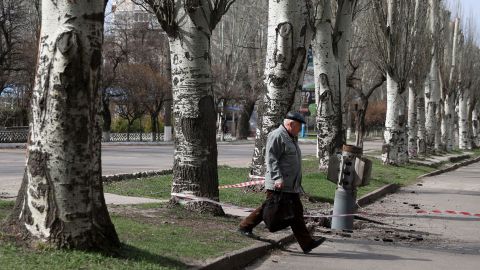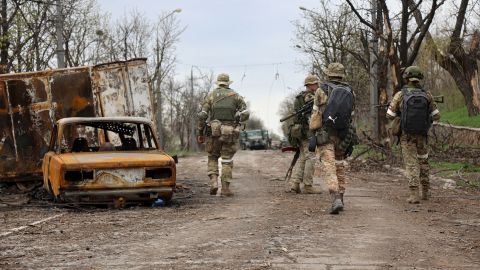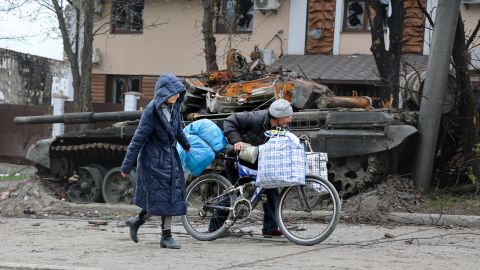[ad_1]
CNN
—
Phase two of Russia’s invasion of Ukraine – an offensive in the eastern Donbas region – is underway. The question is whether it will be any more successful and competent than phase one, and whether Ukraine will have enough troops and weapons to impede or even block it.
Russian Foreign Minister Sergey Lavrov said Tuesday that the operation in the Donbas is “a very important moment of this entire special operation.”
The Russian goal is clear and publicly stated: to secure all of Ukraine’s eastern regions of Donetsk and Luhansk – parts of which Russian-backed separatists have controlled since 2014. A second aim is to crush the remaining resistance in the port city of Mariupol to consolidate a land bridge linking the Russian region of Rostov with Crimea, which Russia seized from Ukraine eight years ago.
To those ends, Russian forces that were deployed to the north and east of Kyiv have been redeployed and in some cases reconstituted after suffering heavy losses.
Now they – and fresher units – are piling into Ukraine from the northeast. US officials estimate that Russia has mobilized some 78 battalion tactical groups in eastern Ukraine – probably about 75,000 troops. Still more are being assembled in Russian border regions.
So far, their tactics have been straight out of the Russian playbook: massive use of artillery, rocket systems and missiles followed by armor advancing. Cities in Luhansk such as Severodonetsk, Popasna and Rubizhne have been reduced to rubble, with power, gas and water supplies destroyed.
But Russian progress on the ground has been modest. That may be a result of not taking time to regroup after the battering they took in February and March.
The Institute for the Study of War (ISW) says that “Russian forces did not take the operational pause that was likely necessary to reconstitute and properly integrate damaged units withdrawn from northeastern Ukraine into operations in eastern Ukraine.”
US officials have assessed that Russia has lost up to 25% of the combat firepower it had before the invasion.
CNN analysis of satellite imagery, dozens of social media videos and the statements of both sides suggest the Russians are now trying to advance on three axes.
Imagine the Donbas as a square: Russian forces are already on three sides – leaving only the west open to the Ukrainians for reinforcements and, if necessary, retreat.
From the south and the east, forward Russian units have advanced a few kilometers at best this month. In the south they had already made progress eating into Zaporizhzhia region, which neighbors Donetsk. This week, they began shelling villages well inside Zaporizhzhia.
From the north, after taking the city of Izium at the beginning of this month, they have made little further progress.
What’s unclear at this stage is whether the Russians can and will change gear, and a better-coordinated offensive is around the corner. The report card from the Kyiv campaign suggests otherwise, but US officials believe that for now Russia is still conducting “shaping operations … to make sure they have logistics and sustainment in place.”
Even so, the ISW assesses that “The Russian military is unlikely to have addressed the root causes – poor coordination, the inability to conduct cross-country operations, and low morale – that impeded prior offensives.”

The Ukrainians have shown themselves to be canny tacticians in this conflict, ceding territory to preserve resources but using their knowledge of the land and their mobility to inflict losses on Russian units.
This week Ukrainian units withdrew from the town of Kreminna in Luhansk region when confronted with overwhelming firepower.
Now they have to decide if they will mount static defenses, which could lead to units being destroyed or surrounded in the face of Russia’s artillery, rockets and armored assault. The alternative is mobile defense – fighting and withdrawing from less vital terrain, hitting the Russians as they fall back and then holding their lines in terrain of their choosing.
Simultaneously the Ukrainians will look to disrupt Russian supply lines – sowing confusion while challenging Russian logistics and morale. And morale in some Russian units – redeployed for their second offensive in as many months – may be brittle.

One of the Russian targets is the city of Sloviansk, but the surrounding territory includes forests, rivers and marshes – difficult to transit and requiring specialist bridging equipment. Where the Russians are confined to roads, as became clear north of Kyiv, they are more vulnerable to both Ukrainian drones and light anti-tank missiles.
Nor are the Ukrainians playing defense only; in recent days small units have made modest gains east and south of Kharkiv, potentially threatening Russian supply lines. If they can sustain this, the Russians would have to dedicate units to protecting these lines.
There are already signs that Ukrainian special forces are operating behind Russian lines: last week a road bridge on a main route in from Russia was blown up. There was also unexplained damage to a railway bridge inside Russia, on the edge of Belgorod. The Russian military relies on railways for much of its logistics. In this aspect of the battle, Western intelligence support may play a critical role.
Another important aspect of the fight to come is cultural. Ukrainian units enjoy some autonomy and are encouraged to exploit opportunities on the battlefield. Even in the absence of clear direction or orders, they have the motivation to fight. By contrast, the Russian command chain is rigid and the culture does not encourage enterprise.
Even so the Ukrainians also face considerable risks. They are fighting – essentially – within a box that could close if the Russians were successful in one or more directions. They will have to maneuver smartly as they did around Kyiv, constantly alert for the risk of being surrounded.

When Mariupol falls, the Russians can redirect the forces that were dedicated to that assault, but they have been degraded and exhausted by nearly two months of urban combat.
Above all, in a race against time, Ukraine needs a constant resupply of weapons and ammunition, much of which must now come from outside the country through a lengthy supply line vulnerable to being interdicted. They need more anti-tank weapons and mobile air defenses.
Counterattacks to disrupt the Russian offensive would need to be protected from the air.
On Tuesday, a senior US official said Washington was working “around the clock” to get weapons to Ukraine at “unprecedented” speed. The United States has already authorized $2.3 billion in shipments of weapons and equipment to Ukraine since the invasion.
“What is unprecedented here is the amount of successive drawdowns that we are moving at this speed,” the official said.
There’s been some talk of the Kremlin wanting tangible progress by May 9, when Russia celebrates Victory Day marking the defeat of Nazi Germany in World War II. At the current rate of progress, that looks unlikely. The much bigger question is whether this conflict stretches into the summer, in a grim war of attrition.
The Russian military would have to rotate units, drawing on limited reserves, to sustain a conflict that has already battered its ground forces. Its calculation (and the Kremlin’s political strategy) will be affected by the effectiveness of Ukrainian resistance and the ability of Western governments to supply Ukraine with more and better equipment.
Writing in War on the Rocks, Jack Watling of the Royal United Services Institute in London said: “Ukraine’s defiance has bought time and an opportunity not only to stave off further Russian gains in the Donbas, but also to shape the battle beyond it. If Ukraine’s allies act today, they may deter or at least prepare for a summer offensive.”
There is an urgency about resupply. Last week, the Biden administration authorized another $800 million security package, which included artillery and anti-artillery radars. On Tuesday, the President indicated more is to come.
Ukraine will require offensive hardware if it’s to punish any vulnerability in Russian lines, and that includes heavy armor (such as battle-ready tanks) as well as a host of other systems.
Watling says there’s no time to lose. “Providing Ukraine with tactical mobile air-defense systems such as the National would allow Ukraine to maneuver near the Russian border and retake towns while raiding Russian supply lines.”
The National – or NASAMS – is an advanced and mobile surface-to-air missile system.
Western governments understand that this is a critical moment: raising the cost of Russia’s “special military operation” to the point where it is unaffordable. The Ukrainians are crying out for even more and better weaponry, especially as they try to keep their air force flying.
Still outnumbered and outgunned, they will need agility, determination and reinforcements to stave off phase two of Vladimir Putin’s war on Ukraine.
[ad_2]
Source link

